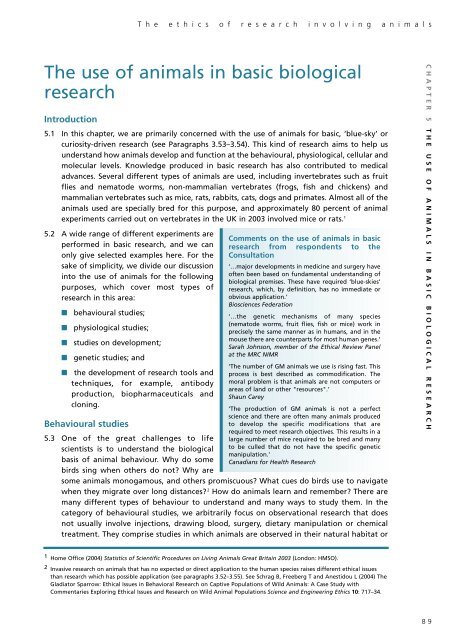The ethics of research involving animals - Nuffield Council on ...
The ethics of research involving animals - Nuffield Council on ...
The ethics of research involving animals - Nuffield Council on ...
You also want an ePaper? Increase the reach of your titles
YUMPU automatically turns print PDFs into web optimized ePapers that Google loves.
T h e e t h i c s o f r e s e a r c h i n v o l v i n g a n i m a l s<br />
<str<strong>on</strong>g>The</str<strong>on</strong>g> use <str<strong>on</strong>g>of</str<strong>on</strong>g> <str<strong>on</strong>g>animals</str<strong>on</strong>g> in basic biological<br />
<str<strong>on</strong>g>research</str<strong>on</strong>g><br />
Introducti<strong>on</strong><br />
5.1 In this chapter, we are primarily c<strong>on</strong>cerned with the use <str<strong>on</strong>g>of</str<strong>on</strong>g> <str<strong>on</strong>g>animals</str<strong>on</strong>g> for basic, ‘blue-sky’ or<br />
curiosity-driven <str<strong>on</strong>g>research</str<strong>on</strong>g> (see Paragraphs 3.53–3.54). This kind <str<strong>on</strong>g>of</str<strong>on</strong>g> <str<strong>on</strong>g>research</str<strong>on</strong>g> aims to help us<br />
understand how <str<strong>on</strong>g>animals</str<strong>on</strong>g> develop and functi<strong>on</strong> at the behavioural, physiological, cellular and<br />
molecular levels. Knowledge produced in basic <str<strong>on</strong>g>research</str<strong>on</strong>g> has also c<strong>on</strong>tributed to medical<br />
advances. Several different types <str<strong>on</strong>g>of</str<strong>on</strong>g> <str<strong>on</strong>g>animals</str<strong>on</strong>g> are used, including invertebrates such as fruit<br />
flies and nematode worms, n<strong>on</strong>-mammalian vertebrates (frogs, fish and chickens) and<br />
mammalian vertebrates such as mice, rats, rabbits, cats, dogs and primates. Almost all <str<strong>on</strong>g>of</str<strong>on</strong>g> the<br />
<str<strong>on</strong>g>animals</str<strong>on</strong>g> used are specially bred for this purpose, and approximately 80 percent <str<strong>on</strong>g>of</str<strong>on</strong>g> animal<br />
experiments carried out <strong>on</strong> vertebrates in the UK in 2003 involved mice or rats. 1<br />
5.2 A wide range <str<strong>on</strong>g>of</str<strong>on</strong>g> different experiments are<br />
performed in basic <str<strong>on</strong>g>research</str<strong>on</strong>g>, and we can<br />
<strong>on</strong>ly give selected examples here. For the<br />
sake <str<strong>on</strong>g>of</str<strong>on</strong>g> simplicity, we divide our discussi<strong>on</strong><br />
into the use <str<strong>on</strong>g>of</str<strong>on</strong>g> <str<strong>on</strong>g>animals</str<strong>on</strong>g> for the following<br />
purposes, which cover most types <str<strong>on</strong>g>of</str<strong>on</strong>g><br />
<str<strong>on</strong>g>research</str<strong>on</strong>g> in this area:<br />
■<br />
■<br />
■<br />
■<br />
■<br />
behavioural studies;<br />
physiological studies;<br />
studies <strong>on</strong> development;<br />
genetic studies; and<br />
the development <str<strong>on</strong>g>of</str<strong>on</strong>g> <str<strong>on</strong>g>research</str<strong>on</strong>g> tools and<br />
techniques, for example, antibody<br />
producti<strong>on</strong>, biopharmaceuticals and<br />
cl<strong>on</strong>ing.<br />
Behavioural studies<br />
5.3 One <str<strong>on</strong>g>of</str<strong>on</strong>g> the great challenges to life<br />
scientists is to understand the biological<br />
basis <str<strong>on</strong>g>of</str<strong>on</strong>g> animal behaviour. Why do some<br />
birds sing when others do not? Why are<br />
Comments <strong>on</strong> the use <str<strong>on</strong>g>of</str<strong>on</strong>g> <str<strong>on</strong>g>animals</str<strong>on</strong>g> in basic<br />
<str<strong>on</strong>g>research</str<strong>on</strong>g> from resp<strong>on</strong>dents to the<br />
C<strong>on</strong>sultati<strong>on</strong><br />
‘…major developments in medicine and surgery have<br />
<str<strong>on</strong>g>of</str<strong>on</strong>g>ten been based <strong>on</strong> fundamental understanding <str<strong>on</strong>g>of</str<strong>on</strong>g><br />
biological premises. <str<strong>on</strong>g>The</str<strong>on</strong>g>se have required ‘blue-skies’<br />
<str<strong>on</strong>g>research</str<strong>on</strong>g>, which, by definiti<strong>on</strong>, has no immediate or<br />
obvious applicati<strong>on</strong>.’<br />
Biosciences Federati<strong>on</strong><br />
‘…the genetic mechanisms <str<strong>on</strong>g>of</str<strong>on</strong>g> many species<br />
(nematode worms, fruit flies, fish or mice) work in<br />
precisely the same manner as in humans, and in the<br />
mouse there are counterparts for most human genes.’<br />
Sarah Johns<strong>on</strong>, member <str<strong>on</strong>g>of</str<strong>on</strong>g> the Ethical Review Panel<br />
at the MRC NIMR<br />
‘<str<strong>on</strong>g>The</str<strong>on</strong>g> number <str<strong>on</strong>g>of</str<strong>on</strong>g> GM <str<strong>on</strong>g>animals</str<strong>on</strong>g> we use is rising fast. This<br />
process is best described as commodificati<strong>on</strong>. <str<strong>on</strong>g>The</str<strong>on</strong>g><br />
moral problem is that <str<strong>on</strong>g>animals</str<strong>on</strong>g> are not computers or<br />
areas <str<strong>on</strong>g>of</str<strong>on</strong>g> land or other "resources".’<br />
Shaun Carey<br />
‘<str<strong>on</strong>g>The</str<strong>on</strong>g> producti<strong>on</strong> <str<strong>on</strong>g>of</str<strong>on</strong>g> GM <str<strong>on</strong>g>animals</str<strong>on</strong>g> is not a perfect<br />
science and there are <str<strong>on</strong>g>of</str<strong>on</strong>g>ten many <str<strong>on</strong>g>animals</str<strong>on</strong>g> produced<br />
to develop the specific modificati<strong>on</strong>s that are<br />
required to meet <str<strong>on</strong>g>research</str<strong>on</strong>g> objectives. This results in a<br />
large number <str<strong>on</strong>g>of</str<strong>on</strong>g> mice required to be bred and many<br />
to be culled that do not have the specific genetic<br />
manipulati<strong>on</strong>.’<br />
Canadians for Health Research<br />
some <str<strong>on</strong>g>animals</str<strong>on</strong>g> m<strong>on</strong>ogamous, and others promiscuous? What cues do birds use to navigate<br />
when they migrate over l<strong>on</strong>g distances? 2 How do <str<strong>on</strong>g>animals</str<strong>on</strong>g> learn and remember? <str<strong>on</strong>g>The</str<strong>on</strong>g>re are<br />
many different types <str<strong>on</strong>g>of</str<strong>on</strong>g> behaviour to understand and many ways to study them. In the<br />
category <str<strong>on</strong>g>of</str<strong>on</strong>g> behavioural studies, we arbitrarily focus <strong>on</strong> observati<strong>on</strong>al <str<strong>on</strong>g>research</str<strong>on</strong>g> that does<br />
not usually involve injecti<strong>on</strong>s, drawing blood, surgery, dietary manipulati<strong>on</strong> or chemical<br />
treatment. <str<strong>on</strong>g>The</str<strong>on</strong>g>y comprise studies in which <str<strong>on</strong>g>animals</str<strong>on</strong>g> are observed in their natural habitat or<br />
CHAPTER 5 THE USE OF ANIMALS IN BASIC BIOLOGICAL RESEARCH<br />
1 Home Office (2004) Statistics <str<strong>on</strong>g>of</str<strong>on</strong>g> Scientific Procedures <strong>on</strong> Living Animals Great Britain 2003 (L<strong>on</strong>d<strong>on</strong>: HMSO).<br />
2 Invasive <str<strong>on</strong>g>research</str<strong>on</strong>g> <strong>on</strong> <str<strong>on</strong>g>animals</str<strong>on</strong>g> that has no expected or direct applicati<strong>on</strong> to the human species raises different ethical issues<br />
than <str<strong>on</strong>g>research</str<strong>on</strong>g> which has possible applicati<strong>on</strong> (see paragraphs 3.52–3.55). See Schrag B, Freeberg T and Anestidou L (2004) <str<strong>on</strong>g>The</str<strong>on</strong>g><br />
Gladiator Sparrow: Ethical Issues in Behavioral Research <strong>on</strong> Captive Populati<strong>on</strong>s <str<strong>on</strong>g>of</str<strong>on</strong>g> Wild Animals: A Case Study with<br />
Commentaries Exploring Ethical Issues and Research <strong>on</strong> Wild Animal Populati<strong>on</strong>s Science and Engineering Ethics 10: 717–34.<br />
89
















